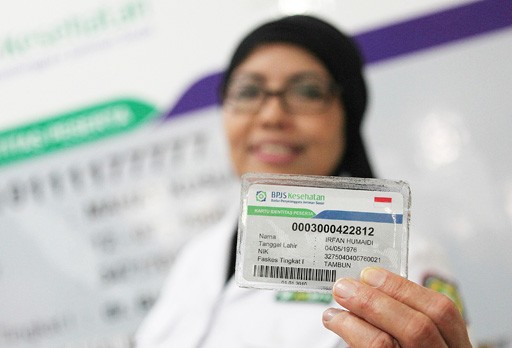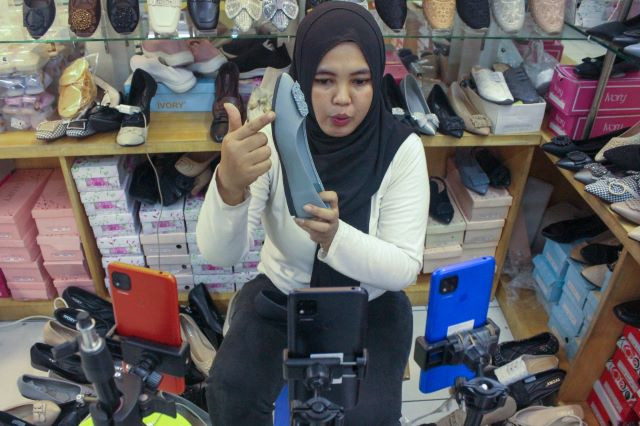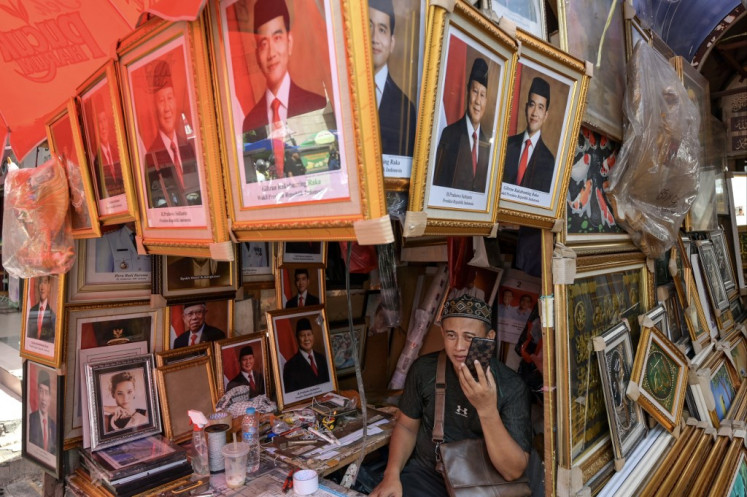Promoting proper self-medication
In both years since the JKN was introduced, BPJS Kesehatan has suffered a deficit, reaching Rp 3.3 trillion (US$246.26 million) in 2014 and Rp 6 trillion in 2016. The government has offered state investment to BPJS Kesehatan of Rp 6.8 trillion. Given the problems the BPJS has faced in implementing the program, it is proper now that the government promote the notion of self-help medication, in an attempt to reduce the burden on the JKN.
Change Size
 Healthcare card: Health insurance firm PT Askes’ director Sri Endang Tidarwati shows a health insurance card in Jakarta, in this file photo. The BPJS Kesehatan (Healthcare and Social Security Agency) scheme became effective on Jan. 1, 2014 (JP/-)
Healthcare card: Health insurance firm PT Askes’ director Sri Endang Tidarwati shows a health insurance card in Jakarta, in this file photo. The BPJS Kesehatan (Healthcare and Social Security Agency) scheme became effective on Jan. 1, 2014 (JP/-)
H
ealth is one of the main indicators of a communities’ wellbeing. Because of this, the government has set development of the health sector as one of the main priorities of national policy.
Furthermore, the health sector in Indonesia is facing a number of complex problems. As such it is only right that this sector features as one of the main subjects of national development. In turn, an improved health sector will contribute greatly to the quality of life of the Indonesian people.
Despite a number of positive developments in the health sector, a number of challenges require immediate response. These deal with the availability of medication that is more widespread, evenly distributed and affordable.
Disparity of access and quality of health services between regions and socio-economic groups; delays and problems in funding, regulation and organizational capacities; and health service development between central and peripheral regions remain unequal (Binfar-Kemenkes, 2013 ).
Other problems emerge from the implementation of the National Health Insurance (JKN) program that provides universal health insurance through the Healthcare Social Security Agency (BPJS Kesehatan). Problems include the sustainability of funding for this program.
In both years since the JKN was introduced, BPJS Kesehatan has suffered a deficit, reaching Rp 3.3 trillion (US$246.26 million) in 2014 and Rp 6 trillion in 2016. The government has offered state investment to BPJS Kesehatan of Rp 6.8 trillion.
Given the problems the BPJS has faced in implementing the program, it is proper now that the government promote the notion of self-help medication, in an attempt to reduce the burden on the JKN.
This concept involves the idea that the members of the community improve their ability to provide self-administered health care without having to depend on government assistance.
Unfortunately, attempts at pushing self-medication to the forefront of health care face many challenges, such as a lack of infrastructure, unequal distribution and limited provision of medicine in the regions.
Data indicate that the need for self-medication is very high. According to the National Social Economy Survey (Susenas) carried out by the Central Statistics Agency (BPS) in 2014, 61.05 percent of the Indonesian people administer self-care.
From this percentage, 90.54 percent of them use medicine that is classified as “modern”. In terms of funding, a study conducted in Mexico shows that the increased provision of self-medication contributed to decreasing the number of self-prescriptions by up to 20 percent during the period between 1989 and 1999.
The survey of the World Self-Medication Industry (WSMI) in a number of countries concluded that the use of self-help drugs was relatively high and was used for common illnesses.
In South Africa, the percentage was 37 percent; in the US, 33 percent; in Australia and German, 28 percent: in Spain, England and Sweden, 24 percent; in Switzerland, 22 percent; and in Mexico and Italy, 21 and 20 percent, respectively.
The WSMI also provided data regarding the rate of satisfaction of the use of self-medication, namely for Mexico with 14 percent, the US with 92 percent, England with 83 percent, South Africa with 81 percent, Canada with 80 percent and in Australia with 75 percent.
A number of studies in various countries show the importance of self- medication. A study in India shows that one of the main reasons for using self-medication is to treat common illnesses (according to 35. 9 percent of respondents).
A study in Thailand focused on the expenses of households before the 1998 financial crisis. When compared with the conditions of 1996, people of all levels of income (except decile 9 groups or the upper-middle class), there was an increase in expenditure on self-help medication and a decrease in expenditure on treatment at health-care providers.
Before the crisis (in 1994 and 1996 ), a part of health treatment in Thailand made use of health-care providers rather than self-help medication. However, after the crisis of 1998, the latter has become the main choice of health treatment in Thailand.
A study in China concludes that consumption of self-help medication drugs accounts for 40 to 50 percent of the drug market. At the same time, the consumption of prescription drugs is still around 33 to 40 percent. This is consistent with the ageing population in China. The sale of self-help drugs has increased about 17 percent in China, and will reach the highest levels for the Asia-Africa region. In 2020, it is projected that China will be the country with the highest rate of self-help drug consumption in the world.
Given the important role of self-help medication, a few things must be done: the first is to safeguard the pharmaceutical industry. This would spearhead the implementation of self-help medication. By providing a favorable business environment, the government would be able to increase the competitive edge of the domestic pharmaceutical industry.
Second, with respect to consumers, the price and affordability of drugs are crucial. Self-medication will be a viable choice if the prices of self-medication drugs are also relatively low.
Furthermore, access to these drugs should be made easier and should be available in neighborhood convenience stores. In this regard, the government must ensure the availability of drugs in peripheral regions, where access to the drug market is relatively limited.
Third, simplifying categorization of drugs. At the moment there are three types: freely distributed (self-medication medicine), limited through relatively freely distributed and restricted. This should be simplified into two, namely freely distributed and restricted. However, this simplification should not compromise safety of use. Other than this, simplifying the categorization should also involve simplification of the color of drug labels.
At the moment there are three labels: red (restricted); blue (limited through relatively freely distributed) and green (freely distributed). This should be simplified into red for restricted drugs and a label without any marking or color for freely distributed drugs. The fourth element is systematic dissemination of information surrounding self-medication drugs.
Distribution of information will be more effective if it uses the local language in the labelling of the drugs, rather than just using color-coding.
***
The writer is a senior economist at the Institute for Development of Economics and Finance (Indef).
---------------
We are looking for information, opinions, and in-depth analysis from experts or scholars in a variety of fields. We choose articles based on facts or opinions about general news, as well as quality analysis and commentary about Indonesia or international events. Send your piece to community@jakpost.com.









